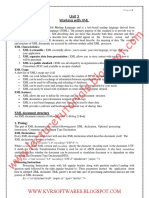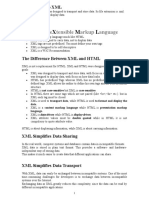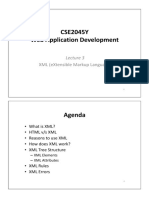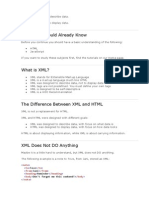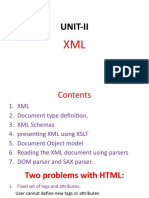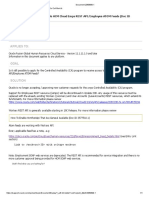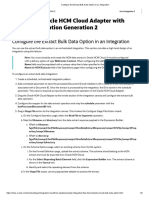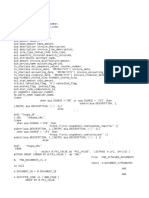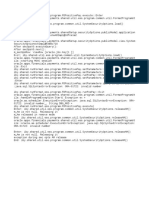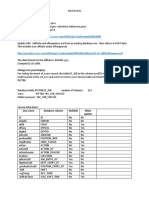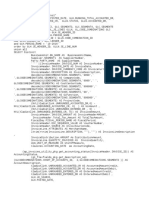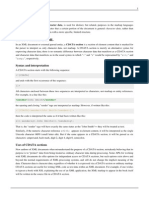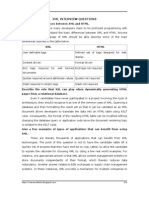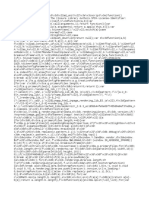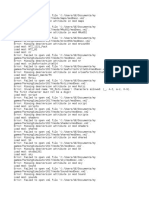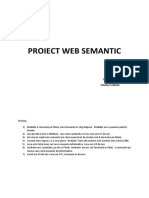4/21/23, 11:19 PM XML Tutorial for Beginners
XML Tutorial for Beginners
By Paul Jackson Updated March 11, 2023
What is XML?
XML stands for eXtensible Markup Language.
It is a language (not> a programming
language) that uses the markup and can
extend. It is derived from Standard
Generalized Markup Language(SGML). XML
also uses DTDs (Document Type Definitions)
to define the XML document structure.
XML is not for handling computational
operations and algorithms. Thus, XML is not a programming language. The main goal is to
transport data not to display information. XML bridges the gap between human readability
and machine readability. Unlike HTML tags, XML tags are self-descriptive.
XML is an open format. The filename extension of XML is .xml
In this XML tutorial, you will learn:
What is XML?
History of XML
XML Features
XML Encoding
XML Syntax
XML Declaration
XML Comments
XML Tags and Elements
XML Attributes
Attribute versus Element
XML Entities
HTML versus XML
https://www.guru99.com/xml-tutorials.html#11 1/28
4/21/23, 11:19 PM XML Tutorial for Beginners
JSON versus XML
XML DTD
XML DOM
XML Validation
XML Namespaces
XML Editors
XML Parsers
SAX
XML Data Binding
XML Schemas
Advantages of XML
Disadvantages of XML
History of XML
XML started way back in 1996 and was first published in 1998. World Wide Web Consortium
(W3C) is the developer of XML, and it became a W3C recommendation in 1998.
There are two versions of XML.
1. XML 1.0
2. XML 1.1
XML 1.1 is the latest version. Yet, XML 1.0 is the most used version.
EXPLORE MORE
Learn Java
Programming with
Beginners Tutorial
08:32
Linux Tutorial for
Beginners: Introduction
to Linux Operating...
01:35
What is Integration
Testing Software Testing
Editors of XML are:
https://www.guru99.com/xml-tutorials.html#11 2/28
4/21/23, 11:19 PM XML Tutorial for Beginners
Tim Bray,
Jean Paoli,
C. M. Sperberg,
Eve Maler,
François Yergeau.
XML Features
Here are some important features of XML:
It is extensible and human-readable.
It is platform and language independent.
It preserves white space.
Overall simplicity.
Self-descriptive nature.
It separates data from HTML.
XML tags are not predefined. You need to define your customized tags.
XML was designed to carry data, not to display that data.
Mark-up code of XML is easy to understand for a human.
Well-structured format is easy to read and write from programs.
XML is an extensible markup language like HTML.
XML Encoding
Encoding is the conversion of Unicode characters to their binary representation. UTF is use
for XML encoding. UTF stands for UCS (UCS stands for Universal Character Set)
Transformation Format.
Mainly, there are two types of UTF encoding.
1. UTF-8 : UTF-8 uses 8-bits to represent the characters.
Example:
<?xml version="1.0" encoding="UTF-8"?>
https://www.guru99.com/xml-tutorials.html#11 3/28
4/21/23, 11:19 PM XML Tutorial for Beginners
2. UTF-16
It uses 16-bits to represent the characters.
Example:
<?xml version="1.0" encoding="UTF-16"?>
You can use encoding inside the XML declaration. UTF-8 is the default encoding in XML.
XML Syntax
The below code segment shows the basic XML syntax.
<?xml version = "1.0" encoding = "UTF-8" ?>
<root>
<child>
<subchild>.....</subchild>
</child>
</root>
XML Declaration
XML declaration consists of the XML version, character encoding or/and standalone status.
The declaration is optional.
Syntax for XML Declaration
The below code segment shows the syntax for XML declaration.
<?xml version="version_number," encoding="character_encoding"
standalone="yes_or_no" ?>
https://www.guru99.com/xml-tutorials.html#11 4/28
4/21/23, 11:19 PM XML Tutorial for Beginners
XML Declaration Rules
Following are XML declaration rules.
If the XML declaration is present, it must be the first thing that appears.
The XML declaration is case sensitive, and it must start with the lowercased <?xml.
It has no closing tag.
Example of XML Declaration
Following code segment shows an example of an XML declaration.
<?xml version="1.0" encoding="UTF-8" standalone="no" ?>
XML Comments
Comments are optional. Adding comments help to understand the document content.
Syntax for XML Comments
A comment begins with <!– and ends with –>.
Following code segment shows the syntax for XML comments.
<!-- Add your comment here -->
XML Tags and Elements
Tags work as pairs except for declarations. Every tag pair consists of an opening tag (also
known as the start tag) and a closing tag (also known as the end tag).
Tag names are enclosed in <>. For a particular tag pair, the start and end tags must be
identical except the end tag has / after the <.
https://www.guru99.com/xml-tutorials.html#11 5/28
4/21/23, 11:19 PM XML Tutorial for Beginners
<name>...</name>
Anything between the opening and closing tags is referred to as content.
Opening tag, content, and closing tag, altogether, is referred to as an element.
Opening tag + content + closing tag = an element
Note: Elements may also contain attributes. You will learn the attributes very soon.
Let us consider the below element.
<age>20</age>
In the above element,
age is the name of the element.
Note: Tag name also referred to as an element or element name.
<age> – opening tag
25 – content
</age> – closing tag.
If there is no content between the tags, as shown below, it referred to as empty tags.
<result></result>
XML Tag and Element Rules
Following list shows XML tag and element rules.
https://www.guru99.com/xml-tutorials.html#11 6/28
4/21/23, 11:19 PM XML Tutorial for Beginners
Tags are case sensitive.
Example:
Correct:
___
<age>20</age>
Wrong:
<age>20</Age>
Note: AGE, Age, and age are three different names in XML.
All XML documents must contain a single root element.
All elements must have a closing tag (except for declarations).
A tag name must begin with a letter or an underscore, and it cannot start with the XML.
A tag name can contain letters, digits, hyphens, underscores, and periods. Hyphens
underscore, and periods are the only punctuation marks allowed.
A tag name cannot contain spaces.
All elements must be nested properly.
Example:
https://www.guru99.com/xml-tutorials.html#11 7/28
4/21/23, 11:19 PM XML Tutorial for Beginners
Correct:
<b><u>This text is bold and italic</u></b>
Wrong:
<b><u>This text is bold and italic.</b></u>
XML Attributes
Attribute for an element is placed after the tag name in the start tag. You can add more than
one attribute for a single element with different attribute names.
Let’s consider the below XML document.
<company name="ABC Holdings" location="London">
<chairman>Mr. John</chairman>
<gm>Mr. Wood</gm>
</company>
There are two attributes in the company element, i.e. name and location.
Let’s study the name attribute,
name=”ABC Holdings” – an attribute
name – attribute name
ABC Holdings – attribute value
Note: An attribute name is also known as an attribute.
Also, note that in the above example, the company is the root element.
XML Attribute Rules
https://www.guru99.com/xml-tutorials.html#11 8/28
4/21/23, 11:19 PM XML Tutorial for Beginners
The below list shows XML attribute rules.
Attribute values must be within quotes.
An element cannot contain several attributes with the same name.
Attribute versus Element
Are you still confused about the difference between an attribute and an element? Here is
another example.
Let’s consider documents A and B given below.
Document A:
<teacher subject="English">
<name>Mr. John</name>.
<qualification>Graduate</qualification>
</teacher>
Document B:
<teacher>
<subject>English</subject>
<name>Mr. John</name>
<qualification>Graduate</qualification>
</teacher>
In document A, the subject is an attribute.
In document B, the subject is an element.
XML Entities
What are XML Entities?
https://www.guru99.com/xml-tutorials.html#11 9/28
4/21/23, 11:19 PM XML Tutorial for Beginners
In simple terms, entities are a way of representing special characters. Entities are also
known as entity references.
Why You Need XML Entities?
Some characters (such as “, & <, and so on) are reserved in XML. They are referred to as
special characters and cannot be directly used for other purposes.
For example, the < and > symbols a used for tags. You cannot directly type from the
keyboard for less than and greater than signs. Instead, you need to use entities.
Following table shows some of the popular XML entities.
Character Description Entity Name Usage
“ Quotation mark (double quote) quot "
& Ampersand amp &
‘ Apostrophe (single quote) apos '
< Less than sign lt <
> Greater than sign gt >
Example:
<friend>
<name>My friends are Alice & Jane.</name>
</friend>
https://www.guru99.com/xml-tutorials.html#11 10/28
4/21/23, 11:19 PM XML Tutorial for Beginners
HTML versus XML
Similarities between HTML and XML
Following list shows the similarities between HTML and XML.
Both are open formats.
Both are markup languages.
Both use tags and attributes to describe the content.
Differences between HTML and XML
Even though XML is like HTML, XML is not a replacement for HTML. There are some
significant differences between HTML and XML as well.
Following list table show a comparison between HTML and XML.
HTML XML
Stands for Hypertext Markup Language Extensible Markup Language
Type of A framework for specifying
A predefined markup language.
language markup languages.
Structural
Not provided. Provided.
details
Purpose Used to display data. Used to transport data
Driven by Format driven. Content-driven.
Nature Has a static nature. Has a dynamic nature.
Tag type Predefined tags. User-defined tags.
Tag limit A limited number of tags are available. Tags are extensible.
It is not necessary to use closing tags
Closing tags Closing tags are mandatory.
(but recommended to use closing tags).
https://www.guru99.com/xml-tutorials.html#11 11/28
4/21/23, 11:19 PM XML Tutorial for Beginners
HTML XML
Namespace
Not supported. Supported.
support
Case sensitivity Tags are not case-sensitive. Tags are case-sensitive.
White space cannot preserve (can White space preserved
White space
ignore white space). (cannot ignore white space).
Parsing in
Not needed any extra application. Need DOM implementation.
JavaScript
Code nesting Not necessarily needed. Needed.
Errors Can ignore small errors. Errors are not allowed.
Filename
.html or .htm .xml
Extension
Size Comparatively large. Comparatively small.
Quotes are not required for attribute Required for XML attribute
Quotes
values. values.
Objects have to be expressed
Object support Offers native object support.
by conventions.
Need to use xsi:nil on
Null support Natively recognizes the null value.
elements.
Formatting Provides direct mapping for application Require more significant
decisions data. effort.
Less steep learning curve compared to
Learning curve Steep learning curve.
XML.
https://www.w3.org/TR/xml1
Website https://html.spec.whatwg.org/
1/
https://www.guru99.com/xml-tutorials.html#11 12/28
4/21/23, 11:19 PM XML Tutorial for Beginners
Basic HTML Syntax
<!DOCTYPE html>
<html lang="en">
<head>
<meta charset="UTF-8">
<meta http-equiv="X-UA-Compatible" content="IE=edge">
<meta name="viewport" content="width=device-width, initial-
scale=1.0">
<title>Document</title>
</head>
<body>
</body>
</html>
Basic XML Syntax
<?xml version = "1.0" encoding = "UTF-8" ?>
<root>
<child>
<subchild>.....</subchild>
</child>
</root>
Same example with HTML and XML
With HTML
<!DOCTYPE html>
<html lang="en">
<head>
<meta charset="UTF-8">
<meta http-equiv="X-UA-Compatible" content="IE=edge">
<meta name="viewport" content="width=device-width, initial-
scale=1.0">
https://www.guru99.com/xml-tutorials.html#11 13/28
4/21/23, 11:19 PM XML Tutorial for Beginners
<title>Document</title>
</head>
<body>
<p>Book</p>
<p>Name: Anna Karenina</p>
<p>Author: Leo Tolstoy</p>
<p>Publisher: The Russian Messenger</p>
</body>
</html>
With XML
<?xml version = "1.0" encoding = "UTF-8" ?>
<book>
<name>Anna Karenina</name>
<author>Leo Tolstoy</author>
<publisher>The Russian Messenger</publisher>
</book>
JSON versus XML
Similarities between JSON and XML
The below list shows the similarities between JSON and XML.
Both are open formats.
Both are self-describing.
Both have a hierarchical structure.
Both can parse and use by several programming languages.
Differences between JSON and XML
There are several differences between XML and JSON as well.
The below tables show a comparison between JSON and XML.
https://www.guru99.com/xml-tutorials.html#11 14/28
4/21/23, 11:19 PM XML Tutorial for Beginners
JSON XML
Stands for JavaScript Object Notation Extensible Markup Language
Extended from JavaScript SGML
Data stored as key-value
Data storage Data stored as a tree structure.
pairs.
Namespaces No support for namespaces. Supports namespaces.
Adding comments is not
Comments Can add comments.
supported.
Readily accessible as JSON
Data accessibility Data need to be parsed.
objects.
Adding metadata is not
Metadata Can write metadata.
supported.
JSON types: string, number,
Types All XML data should be strings.
array, Boolean.
Data types of Supports text and number Support many data types (text,
support data types only. numbers, images, so on)
More support for arrays
Array’s support No or less support for arrays.
compared to XML.
The object has to be express by
Object’s support Native support for object.
conventions.
AJAX toolkit
Supported. Not fully supported.
support
Retrieving values Easy. Difficult.
Deserializing/seria Developers have to write JavaScript
Fully automated.
lizing code.
https://www.guru99.com/xml-tutorials.html#11 15/28
4/21/23, 11:19 PM XML Tutorial for Beginners
JSON XML
Cross-browser XML parsing can be
Browser support Supported by most browsers.
tricky.
Only supports UTF-8
Encoding It supports various encoding.
encoding.
Display
No display capabilities. Offer display capabilities.
capabilities
Document size Smaller than XML. Large than JSON.
Filename
.json .xml
Extension
Security Less secured. More secure than JSON.
Easy to read Relatively easy. Relatively difficult.
Learning curve Easy to learn. Steep learning curve.
https://www.json.org/json-e
Website https://www.w3.org/TR/xml11/
n.html
Basic JSON Syntax
{string:value, .......}
Same example with JSON and XML
With JSON
{"books":[
{"name":"Anna Karenina", "author":"Leo Tolstoy"},
{"name":"One Hundred Years of Solitude", "author":"Gabriel Garcia
Marquez"},
{"name":"The Great Gatsby", "author":"Scott Fitzgerald"},
https://www.guru99.com/xml-tutorials.html#11 16/28
4/21/23, 11:19 PM XML Tutorial for Beginners
{"name":"Invisible Man", "author":"Ralph Ellison"}
]}
With XML
<?xml version = "1.0" encoding = "UTF-8" ?>
<books>
<book>
<name>Anna Karenina</name>
<author>Leo Tolstoy</author>
</book>
<book>
<name>One Hundred Years of Solitude</name>
<author>Gabriel Garcia Marquez</author>
</book>
<book>
<name>The Great Gatsby</name>
<author>Scott Fitzgerald</author>
</book>
<book>
<name>Invisible Man</name>
<author>Ralph Ellison</author>
</book>
</books>
XML DTD
What is DTD?
DTD stands for Document Type Definition. It defines the structure of an XML document using
some legal elements. XML DTD is optional.
DTD Rules
Following list shows DTD rules.
https://www.guru99.com/xml-tutorials.html#11 17/28
4/21/23, 11:19 PM XML Tutorial for Beginners
If DTD is present, it must appear at the start of the document (only the XML declaration
can appear above the DTD).
The element declaration must start with an ! mark.
The DTD name and element type of the root element must be the same.
Examples of DTD
Example of an internal DTD:
<?xml version="1.0" encoding="UTF-8" ?>
<!DOCTYPE student [
<!ELEMENT student (firstname,lastname,school)>
<!ELEMENT firstname (#PCDATA)>
<!ELEMENT lastname (#PCDATA)>
<!ELEMENT school (#PCDATA)>
]>
<student>
<firstname>Mark</firstname>
<lastname>Wood</lastname>
<school>Hills College</school>
</student>
In the above example,
!DOCTYPE student indicates the beginning of the DTD declaration. And the student is
the root element of the XML document.
!ELEMENT student indicates the student element must contain firstname, lastname and
school elements.
!ELEMENT firstname indicates the firstname element is of type #PCDATA (Parsed
Character Data).
!ELEMENT lastname indicates the lastname element is of type #PCDATA.
!ELEMENT school indicates the school element is of type #PCDATA.
Example of an external DTD:
https://www.guru99.com/xml-tutorials.html#11 18/28
4/21/23, 11:19 PM XML Tutorial for Beginners
<?xml version="1.0" encoding="UTF-8" ?>
<!DOCTYPE student SYSTEM "student.dtd">
<student>
<firstname>Mark</firstname>
<lastname>Wood</lastname>
<school>Hills College</school>
</student>
The DTD file content (student.dtd) as follows.
<!ELEMENT student (firstname,lastname,school)>
<!ELEMENT firstname (#PCDATA)>
<!ELEMENT lastname (#PCDATA)>
<!ELEMENT school (#PCDATA)>
XML DOM
What is DOM?
DOM stands for Document Object Model. It defines a standard manner of accessing and
manipulating XML documents. DOM has a (hierarchical) tree structure.
Example of DOM
Let’s consider the below XML document.
<?xml version="1.0" encoding="UTF-8" ?>
<school>
<student>
<name>
<first_name>Alex</first_name>
<last_name>Clarke</last_name>
</name>
<age>14</age>
<address>No. 35, Flower Road, Leeds</address>
https://www.guru99.com/xml-tutorials.html#11 19/28
4/21/23, 11:19 PM XML Tutorial for Beginners
</student>
</school>
The tree structure of the above XML file would look like the following image.
XML DOM Example
XML Validation
What are Well-formed XML Documents?
Well-formed XML documents are XML documents with correct syntax.
What are Valid XML Documents?
Valid XML documents are well-formed and also conform to the DTD rules.
XML Namespaces
Why Namespaces?
Namespaces help to avoid element name conflicts.
Namespace Declaration
https://www.guru99.com/xml-tutorials.html#11 20/28
4/21/23, 11:19 PM XML Tutorial for Beginners
Following shows the syntax for the namespace declaration.
<element xmlns:name="URL">
In the above declaration,
The xmlns keyword indicates the beginning of the namespace.
The name is the prefix of the namespace.
The URL is the namespace identifier.
Examples of Namespaces
Following code segment shows an example of namespaces.
<?xml version="1.0" encoding="UTF-8" ?>
<abt:about xmlns:abt="https://www.guru99.com/about-us.html">
<abt:founder>Krishna</abt:founder>
<abt:vision>Fun and Free Education for ALL</abt:vision>
</abt:about>
XML Editors
There are several XML editors available. Any text editor (such as notepad and so on) can use
as an XML editor.
The following list shows some of the popular XML editors in 2021.
1) XML Notepad:
XML Notepad is an open-source editor for XML . It has a tree view and XSL Output on the left
pane and node text on the right. It has an error-debugging window at the bottom.
Key Statistics:
Type – XML editor
Developer – Microsoft
https://www.guru99.com/xml-tutorials.html#11 21/28
4/21/23, 11:19 PM XML Tutorial for Beginners
Supported operating system – Microsoft Windows.
Price – Free
Link: http://microsoft.github.io/XmlNotepad/
2) Stylus Studio:
Stylus Studio is an IDE written in C++ for Extensible Markup Language ( XML ). It allows a user
to edit and transform XML documents, data such as electronic data interchange(EDI), CSV,
and relational data.
Key Statistics:
Type – Integrated development environment (IDE) for XML
Developer – Progress Software Corporation
Supported operating system – Microsoft Windows.
Price – Paid (Please refer to the website given below for the latest price), Free trial
available.
Link: http://www.stylusstudio.com/
3) Altova XMLSpy:
XMLSpy is primarily marketed as a JSON and XML Editor. It has a built-in schema designer
and editor. It includes Visual Studio And Eclipse integration.
Key Statistics:
Type – XML Editor
Developer – Altova
Supported operating system – Microsoft Windows.
Price – Paid (Please refer to the website given below for the latest price), Free trial
available.
Link: https://www.altova.com/xmlspy-xml-editor
https://www.guru99.com/xml-tutorials.html#11 22/28
4/21/23, 11:19 PM XML Tutorial for Beginners
4) Oxygen XML Editor:
Oxygen XML is a cross-platform editor developed in Java. It helps to validate schemas like
DTD, W3C XML Schema, RELAX NG, Schematron, NRL, and NVDL schemas.
Key Statistics:
Type – XML editor
Developer – SyncRO Soft Ltd
Supported operating system – Windows, Linux, and Mac OS X
Price – Paid (Please refer to the website given below for the latest price
Link: https://www.oxygenxml.com/
5) Xmplify:
Xmplify XML Editor provides a fully XML-aware editing environment with DTD and XML
Schema-based auto, automatic document validation, etc.
Key Statistics:
Type – XML Editor
Developer – MOSO Corporation
Supported operating system – Mac OS.
Price – Paid (Please refer to the website given below for the latest price
Link: http://xmplifyapp.com/
XML Parsers
An XML parser is a software library that provides an interface to work with XML documents. It
checks whether the format of the XML document is correct. Some parsers can also validate
the XML documents. Modern-day browsers come with XML parsers.
SAX
SAX stands for Simple API for XML. It is an application program interface (API) for parsing XML
documents. They behave similarly to the event handlers in Java.
https://www.guru99.com/xml-tutorials.html#11 23/28
4/21/23, 11:19 PM XML Tutorial for Beginners
Unlike DOM, SAX is an example of an event-based XML parser.
Here are some important differences between the SAX and DOM.
SAX DOM
Document
Simple API
Stands for Object
for XML
Model
Type of Event- Object-
parser based based
Read and Both read
Read-only
write XML and write
Cannot ins
Insert/upd Can insert/
ert/updat
ate/delete update/del
e/delete n
nodes ete nodes
odes
Good
Memory
memory Varies
efficiency
efficiency
Slower
Faster than
Speed than DOM
SAX Parser
Parser
Suitable Small- Large-sized
for sized files files
XML Data Binding
XML data binding is the representation of data in an XML document as a business object in
the memory of a computer.
There are three approaches for XML data binding.
https://www.guru99.com/xml-tutorials.html#11 24/28
4/21/23, 11:19 PM XML Tutorial for Beginners
XML schema-based data binding: Corresponding XML classes are created based on the
schema.
Class-based data binding: A corresponding XML schema is created based on classes.
Mapping-based data binding: It describes how an existing XML schema maps to a set of
classes (and vice-versa).
There are XML data binding frameworks also.
Examples:
gSOAP
xStream
XML data binding is easy with frameworks. The data binding framework generates a large
amount of code for you. You need to feed in a DTD or XML schema.
XML Schemas
XML schema (also known as XML schema definition or XSD) use to describe the XML
document structure. It is an alternative to DTD.
Why Schema is Important?
DTD is not powerful as schema as it is not extensible and flexible enough. So, it may not be
suitable for some situations. In such a situation schema is important. The main purpose of
using XML schema is to define the elements and attributes of an XML document.
How XML Schema is Different from DTD?
The following comparison shows how XSD (XML Schema) is different from DTD.
DTD XSD
Stands for Document Type Definition XML Schema Definition
Extensibility Not extensible Extensible
Control on XML structure Less control More control
Data types of support Not supported Supported
https://www.guru99.com/xml-tutorials.html#11 25/28
4/21/23, 11:19 PM XML Tutorial for Beginners
DTD XSD
Namespace Support Not supported Supported
Following code segment shows an example of XML schema.
xs:schema xmlns:xs = "http://www.w3.org/2001/XMLSchema">
<xs:element name = "employee">
<xs:complexType>
<xs:sequence>
<xs:element name = "firstname" type = "xs:string" />
<xs:element name = "lastname" type = "xs:string" />
<xs:element name = "phone" type = "xs:int" />
</xs:sequence>
</xs:complexType>
</xs:element>
</xs:schema>
Advantages of XML
Here, pros/benefits of XML:
It made it easy to transport and share data.
XML improves the exchange of data between various platforms.
It is a markup language, which is a set of characters or/and symbols placed in a text
document.
XML indicates how the XML document should look after it is displayed.
It simplifies the platform change process.
It enhances data availability.
It supports multilingual documents and Unicode.
Provide relatively easy to learn and code.
It is a markup language, which is a set of characters or/and symbols placed in a text
document.
It performs validation using DTD and Schema.
https://www.guru99.com/xml-tutorials.html#11 26/28
4/21/23, 11:19 PM XML Tutorial for Beginners
Makes documents transportable across systems and applications. With the help of XML,
you can exchange data quickly between different platforms.
XML separates the data from HTML.
Disadvantages of XML
Here are the cons/drawback of using XML:
XML requires a processing application.
The XML syntax is similar to another alternative ‘text-based’ data transmission formats,
which is sometimes confusing.
No intrinsic data type support
The XML syntax is redundant.
Does not allow the user to create his tags.
Summary
XML stands for eXtensible Markup Language. XML is a language (not a programming
language) that uses the markup and can extend.
The main goal is to transport data, not to display data.
XML 1.1 is the latest version. Yet, XML 1.0 is the most used version.
Tags work as pairs except for declarations.
Opening tag + content + closing tag = an element
Entities are a way of representing special characters.
DTD stands for Document Type Definition. It defines the structure of an XML document
using some legal elements. XML DTD is optional.
DOM stands for Document Object Model. It defines a standard manner of accessing and
manipulating XML documents.
Well-formed XML documents are XML documents with correct syntax.
Valid XML documents are well-formed and also conform to the DTD rules.
Namespaces help to avoid element name conflicts.
You Might Like:
PHP Function: Built in, String, Numeric with Examples
PHP preg_match(): Regular Expressions (Regex)
PHP Registration Form using GET, POST Methods with Example
https://www.guru99.com/xml-tutorials.html#11 27/28
4/21/23, 11:19 PM XML Tutorial for Beginners
PHP Session & PHP Cookies with Example
Laravel Tutorial for Beginners
Prev Report a Bug Next
About
About Us
Advertise with Us
Write For Us
Contact Us
Career Suggestion
SAP Career Suggestion Tool
Software Testing as a Career
Interesting
eBook
Blog
Quiz
SAP eBook
Execute online
Execute Java Online
Execute Javascript
Execute HTML
Execute Python
© Copyright - Guru99 2023 Privacy Policy | Affiliate
Disclaimer | ToS
https://www.guru99.com/xml-tutorials.html#11 28/28















